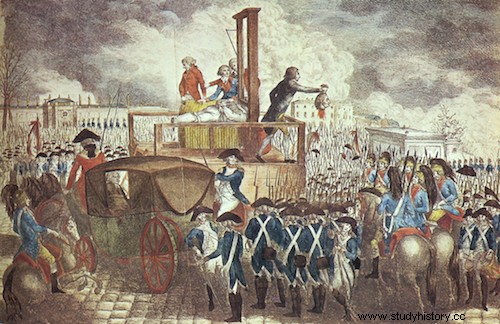- At the end of the 18 th century, France was in the midst of a political revolution. Royal power was overthrown on August 10, 1792:that day, the Sans-Culottes came to seek Louis XVI and the royal family at the Tuileries, abolishing the monarchy.
- The Victory of Valmy, on September 20, is the first military triumph of the revolutionary corps against the Prussian and Austrian troops, monarchists, who came to deliver the king. This engenders the signing of the First Republic, by the Convention, on September 22.
January 21, 1793

Characters
Jacques Pierre Brissot
Jean-Baptiste Cant Hanet dit Cléry
Henry Essex Edgeworth of Firmont
Chretien-Guillaume de Lamoignon de Malesherbes
Louis-Auguste of France known as Louis XVI
Maximilian of Robespierre
Charles-Henri Sanson
Antoine-Joseph Santerre
Raymond de Sèze
Francois Denis Tronchet
Pierre Victurnien Vergniaud
Procedure
Meanwhile, the deposed king, a prisoner in the Temple with his family, awaits his trial. The discovery in the iron cupboard of the Tuileries, on November 20, 1792, of the compromising correspondence with Mirabeau definitively condemns Louis Capet to a trial, accused of plotting with Brunswick who leads the Prussian armies against the State.
The trial of Louis XVI opens on December 10 and ends sixteen days later. It takes place before the Convention, which has become a court. If the Montagnards, led by Robespierre, demand the execution of the king, the Girondins (Brissot, Vergniaud) are more reserved as to the sentence. The deliberations last three days. Despite the ardent defense of his lawyers, in particular Chrétien-Guillaume de Malesherbes and Raymond de Sèze, the king was condemned for high treason and conspiracy against the State by a small majority.
On January 20, Louis XVI bids farewell to his family. Queen Marie-Antoinette is present with the Dauphin as well as Madame Elisabeth, her sister, and Madame Royale, her sister-in-law.
On the 21st, at dawn, his valet Cléry woke him up at 5 a.m. An hour later, Father Henry Essex Edgeworth de Firmont celebrates mass in the cell during which the king receives the last sacrament. He gave his seal and wedding ring to Cléry, his will to the municipal officers, then was escorted by Antoine-Joseph Santerre, commander of the National Guard, who took him to Place de la Révolution (now renamed Place de la Concorde) where stands the guillotine.
On the scaffold, his executioner, Charles-Henri Sanson, and his four assistants awaited him, as did the Abbé de Firmont. Louis XVI was reluctant to have his coat taken off and his hands tied. Addressing the crowd, he exclaims:“People, I die innocent!” then, turning to his executioners, he declares:"Gentlemen, I am innocent of everything with which I am charged. I wish that my blood could cement the happiness of the French. »
The drums resume to cover his voice, the Abbé de Firmont exclaims "Son of Saint Louis, ascend to Heaven!" » , the board tilts and the cleaver, activated by Sanson, falls, it is 10:22 am. The crowd then exclaimed:"Long live the Nation, long live the Republic!" » A world has just collapsed.
Consequences
- With the execution of Louis XVI, France definitively buried the absolute monarchy. This regicide is one of the strong signs of the Terror which symbolizes the dark hours of the Revolution. The death of Louis XVI, causing major political unrest, shook the whole of Europe.
